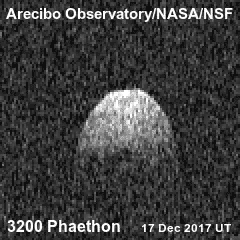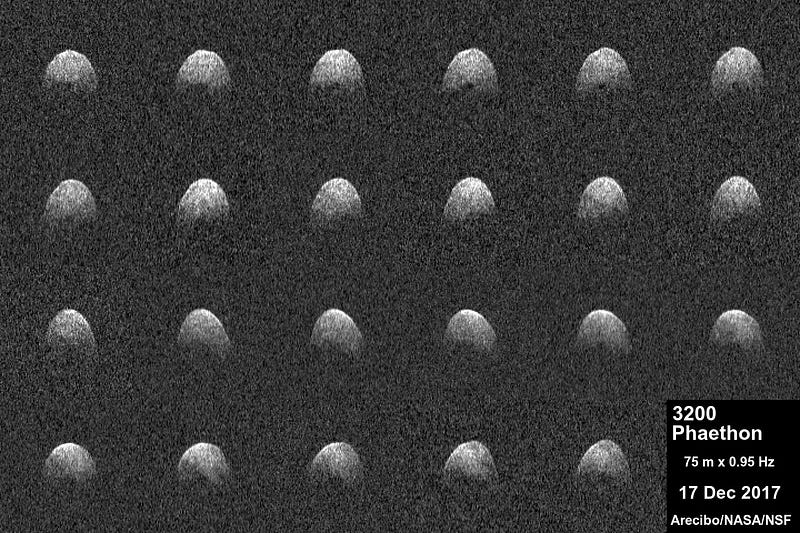Fascinating Insights into the Spinning Asteroid Phaethon
Written on
Chapter 1: Introduction to Asteroid 3200 Phaethon
Asteroid 3200 Phaethon has recently garnered attention due to its increasing rotation speed, a phenomenon that remains unexplained. This small celestial body is set to be studied in detail in two years as part of Japan’s DESTINY+ mission.

Phaethon is notable for several reasons. Primarily, it is the source of the Geminids meteor shower, which lights up the night sky with shooting stars every mid-December. Moreover, it makes a close approach to the Sun, coming within just 0.14 astronomical units — the closest of all known asteroids. Its name derives from Phaethon, the son of Helios, the Sun god.
Additionally, Phaethon is classified as a “rocky comet” due to its trailing dust tail, which differentiates it from traditional comets that are primarily icy. This dust emission occurs when it nears the Sun, causing the rock to shed material.
Section 1.1: The Unique Color of Phaethon
Another intriguing feature of Phaethon is its distinctive glow. The asteroid exhibits a blue hue that has puzzled scientists since its discovery in 1983. Recently, researchers from the Johns Hopkins Applied Physics Laboratory proposed a theory to explain this phenomenon. They believe that as Phaethon approaches the Sun — closer than Mercury — it heats up to the point where the chemical compounds responsible for its red color evaporate, revealing a striking blue surface instead.

DESTINY+ Mission to Explore Phaethon
The upcoming DESTINY+ mission is designed to conduct a close flyby of Phaethon, aiming to gather precise data from just 500 kilometers away. This mission will provide an opportunity to confirm the theories about the asteroid’s characteristics and behavior.
In the course of preparing for this mission, scientists made another surprising discovery: Phaethon is accelerating its spin. Planetologist Sean Marshall, working at the Arecibo Observatory, was involved in this exciting find.
Section 1.2: The Acceleration of Phaethon’s Spin
Marshall was tasked with creating a detailed model of Phaethon, analyzing its shape, size, and rotation speed. However, upon comparing his model with observational data, he noticed a mismatch. The predicted brightest moments did not align with actual observations, leading him to suspect a change in the asteroid’s rotational period since 2021.
Upon further analysis, he discovered that Phaethon’s rotation period shortens by approximately 4 milliseconds each year. While this may seem minor, over decades, these small increments will accumulate significantly, aiding the DESTINY+ mission's observations by allowing for more accurate positional predictions.

Why Is Phaethon Spinning Faster?
The question arises: what causes Phaethon’s increasing rotation speed? Scientists are still investigating, but two primary hypotheses have emerged.
The first theory suggests that mass loss from Phaethon contributes to its acceleration. Recent studies indicate that sodium is escaping from the asteroid due to thermal influences.
The second hypothesis involves the YORP effect, named after its discoverers: Yarkovsky-O’Keefe-Radzievskii-Paddack. This effect indicates that the thermal radiation can influence the rotation speeds of small, irregularly shaped celestial bodies like Phaethon.
These findings regarding Phaethon’s rotation were presented at the American Astronomical Society’s 54th Annual Meeting of the Division for Planetary Sciences.
In the video titled "Major Mars Updates: It's Spinning Faster, Unexplained Molecules, Weird Rocks and More!", experts delve into recent developments regarding celestial bodies, including updates on Phaethon.
Another insightful video, "Spinning Asteroids To Make Space Stations," discusses innovative concepts in space exploration and the implications of asteroid behaviors on future missions.
In conclusion, the exploration of asteroid 3200 Phaethon promises to unravel many mysteries of our solar system, enhancing our understanding of celestial mechanics and the evolution of asteroids.